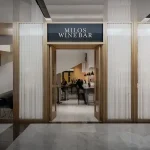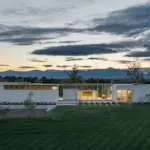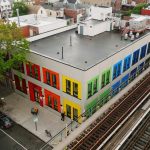Delancey and Essex Municipal Parking Garage, Downtown Manhattan Building, New York Design
Delancey Municipal Garage, New York
Parking Building Development in Manhattan, NY, USA – by Michielli + Wyetzner Architects
Jul 30, 2011
Delancey and Essex Municipal Parking Garage Building New York
NYC Downtown Garage to Get Innovative Cable Façade In Award-Winning Renovation by Michielli + Wyetzner Architects
Project wins a 2011 NYC Design Commission Award
Design: Michielli + Wyetzner Architects
A nearly 40-year-old municipal parking garage in downtown Manhattan is getting a remarkable cable façade as part of a $4 million renovation of the structure. Winner of a 2011 design award from the NYC Design Commission, the five-story, concrete Delancey and Essex Municipal Parking Garage is being completely rehabilitated in a project for the NYC Department of Transportation (DOT). The design, by Michielli + Wyetzner Architects, is part of Mayor Bloomberg’s Design + Construction Excellence Program which has been led by the New York City Department of Design and Construction since 2004.
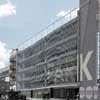
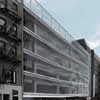
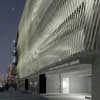
images from Michielli + Wyetzner Architects
The three-dimensional open façade consists of two layers of 1.25” diameter cables, material more commonly seen in DOT road barriers, extended in a continuous weave-like pattern from the second to fifth floors. The front layer folds in and out from the planer inner one behind, creating large-scale moiré patterns that move across the building as the viewer walks or drives up the street. The cable façade replaces a grill-like concrete covering that had begun to deteriorate.
“Unlike most building enclosures, parking garages are often naturally ventilated and open to the elements and that allowed for a wide range of possibilities for the facade” says Frank Michielli, AIA, a firm principal. “We combined that need for openness with the Lower East Side’s history as the roots of the garment industry and a common road barrier material to develop a visually dynamic solution.” In addition to creating patterns, the two diagonal layers of vertical cables angled in slightly different directions also suggest the threads on a loom. The folds extend as much as two feet in front of the building to add to the richness of the patterns and a three dimensional quality that relates to the historic neighboring structures.
The cable used for the façade will be thicker than that used by the DOT, lighter in weight and of a different composition, with a composite fiberglass core and a woven stainless steel jacket covering it. Each cable will be fastened to stainless steel end-fittings with integral turnbuckles for adjustability. The outer folds will be held in place by o-rings at the ends of galvanized steel “combs,” attached to the floor slab at each level. The comb’s horizontal rods extend outwards to fix the outer layer of cables at the correct distance from the façade. Michielli and his firm partner Michael Wyetzner, AIA, conducted numerous studies to assure that the moiré pattern would be continually dynamic and the shifting patterns can appear two or three dimensional with just a small change in the viewer’s position. The changing patterns suggest the aerodynamic flow of moving cars.
The mid-block, concrete building fronts and has entrances on two streets and both will have cable facades. However the wider, more prominent Essex Street entrance will receive a 17-foot tall DOT super-graphic using rubberized paint to create sleeves on the cables. The first floor, which is currently occupied by the NYC Traffic Police will be covered in black ceramic glass panels while building spandrels will be painted in dark gray. A continuous edge of decorative lighting will run between the second and roof levels at the southern end of the façade. The lighting will graze the cable screen and will accentuate the geometry of the façade.
Other repairs and upgrades include adding spaces for 22 bicycles, putting a new protective coating on the concrete floors and restriping them, making roof repairs and replacements, and upgrading the elevator. Construction is expected to start in the beginning of 2012 and be completed by the end of the year.
About Michielli + Wyetzner Architects
Michielli + Wyetzner Architects is a full-service design firm founded by architects responsible for award-winning contemporary architecture for institutional and corporate clients across the United States and abroad. Their projects are distinguished by a clarity of form, elegance of execution and innovative use of materials. The thoroughness of their design approach has resulted in well-integrated solutions to often complex facility requirements.
Michielli + Wyetzner Architects offers the enthusiasm and high-energy of a start-up with the discipline and expediency of a seasoned practitioner, offering combined experience of almost 50 years. Its projects include the New York offices for AECOM, the renovation of Yeshiva University’s Stern College for Women, the Watermill Center for theater visionary Robert Wilson, and Rolltop Observatory in Great Falls, Michigan.
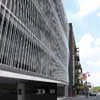

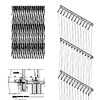
images from Michielli + Wyetzner Architects
Rehabilitation of the Delancey and Essex Municipal Parking Garage
New York City Department of Design and Construction
New York City Department of Transportation
The design goals for the facades of the Delancey and Essex garage include the development of a lightweight, naturally ventilated, visually dynamic façade that contributes to the rich texture of New York City’s Lower East Side neighborhood.
The proposed solution is a surface of lines: a three dimensional, porous façade composed of 1.25” diameter cables that are woven as if on a loom. This concept of weaving is loosely associated with the history of the lower east side and the early garment industry there. The proposed cables are modeled on standard DOT road barrier materials, although used in a new way by turning them sideways and spanning them vertically.
The pattern of the cable design is inspired by the work of various abstract artists such as Naum Gabo and Fred Sandback who defined form and space simply with lines; as well as Optical Art works from the 1960’s, such as Françoise Morellet’s “Grilllge” drawings, that are composed of a system of simple grids overlaid in a way that creates new, larger scale patterns.
The proposed façade solution was produced by offsetting two layers of cable which when viewed together creates large-scale moiré patterns that seemingly move across the face of the building as the viewer’s position changes by walking or driving up the street. The patterns produced and suggestion of movement is linked to the dynamic nature of moving cars within the structure.
To achieve this effect the exterior plane of cables was shaped so that it folds out as much as 2’ from the face of the back layer of cables, which are in a flat plane. The face is pushed in and pulled out in response to the spiral circulation route within the building.
The two planes of lines visually collapse creating dynamic, organic moiré patterns. The patterns vary as the viewer changes their distance and viewing angle from the façade. The movements of the patterns will make the façade seem to come alive. The texture of cable mesh blends seamlessly with the strong texture of the neighborhood context.
Decorative lighting and super-graphics signage will be integrated into the cable structure. Secondary informational signage will be appropriately placed at the garage entrance.
The cables will be attached by o-rings sleeved around the cable and connected to steel tube “combs”. The cables will have integral stainless steel end-fittings that will be have turnbuckles for tightening and adjustability. The termination details will be simple and unobtrusive.
Primary Materials
Façade Cable : 1.25” diameter synthetic fiber cable core with stainless steel braided jacket
Cable End Fittings: Stainless steel / anodized aluminum with integral turnbuckles
Cable Supports: Galvanized plates and tube “combs” painted a dark grey color to match the dark grey paint covering the spandrel panels and columns directly behind the cable façade.
Base Cladding: Ceramic glass panels, hi-gloss black
Spandrel Paint: Spandrels directly behind the cable façade will be painted dark grey. The exterior of the elevator tower will be painted the same color.
Delancey and Essex Municipal Parking Garage – Building Information
Title: Delancey and Essex Street Parking Garage Renovation
Client: New York City Department of Design and Construction ; New York City Department of Transportation
Design team: Michielli + Wyetzner Architects
Frank Michielli AIA LEED AP, Partner; Michael Wyetzner AIA LEED AP Partner; Jason Pogorzala, Project Architect; Kotting Luo, Project Designer; Rebecca Arcaro, Project Designer; Elena Hasbun, Project Designer
Engineering Group Associates – Structural Engineers
Gennady Saratovsky PE; Junhui Jai PE; Christian Lozada; Weimin Nian; Inga Makarovskya
ME Engineers – Mechanical Engineers
Edward Bosco PE LEED AP, Principal; Art Smith, Principal ; Charles Warner PE LEED AP, Principal; Eric Pfeiffer PE LEED AP, Mechanical Engineer; Abdul Tabbara, Electrical Engineer
Tillotson Design Associates – Lighting Designers Suzan Tillotson, Principal; Erin Devries. Lighting Designer
Delancey and Essex Municipal Parking Garage New York images / information from Michielli + Wyetzner Architects
Address: Delancey and Essex Municipal Parking Garage, 105 Essex Street, New York, 10002, United States
Contact Parking Systems: (212) 529-8824
Open Daily 24 Hours
Michielli + Wyetzner Architects
Location: 105 Essex Street, New York, 10002, United States
New York City, USA
New York City Architecture
Contemporary New York Buildings
NYC Architecture Designs – chronological list
New York City Architecture Tours by e-architect
Car Park Buildings – Selection
Veranda multi-storey car park, Holland
Multi-Level Parking voestalpine, Austria
1111 Lincoln Road, Miami Beach, Florida USA – design by architects Herzog & de Meuron
Comments / photos for the Delancey and Essex Municipal Parking Garage Manhattan page welcome


